Abdul Rahman Mowakket (born 1946) is a contemporary sculptor from Syria. [1]
Contents
Abdul Rahman's career as a sculptor spans more than 40 years. He has been fully devoted to artistic work since 1976. He has a private workshop.
Abdul Rahman Mowakket (born 1946) is a contemporary sculptor from Syria. [1]
Abdul Rahman's career as a sculptor spans more than 40 years. He has been fully devoted to artistic work since 1976. He has a private workshop.
He was born in 1946 in Aleppo city. He studied there and graduated with a "good" degree from the Teachers' postgraduate institute. In 1960 he started practicing fine arts, drawing, and sculpture. In 1965 he started his studies of Fine Arts by personal study through a big collection of Fine Art techniques and sciences literature. In 1970 he started his actual artistic activities on the country level with a series of personal, group, and official exhibitions. In 1976 he devoted himself to the Fine Arts by practicing it in his own atelier (workshop) and he began to teach Sculpture in the Fine Arts Centre in Aleppo. In 1980 he went to Italy and studied nude sculpture at the Rome Academy of Fine Art. In Rome, he was introduced to the artistic movement in Rome and to the most important works of art in the squares and the museums of Italy. Also, he exhibited his work in an exhibition in Rome. In 1982 he returned to Syria and began to execute a large number of sculpture works and started to prepare a good number of studies of monumental statues in the favour of many local squares. In 1984 he began to execute a large number of monumental statues in the squares of the city of Aleppo, which he continues to this day. He also presented many statues which have been presented in personal and group exhibitions. He moved to Turkey in 2014 where he shifted his artwork to painting and he had three exhibitions in Mersin, Tarsus and Adana between 2015 and 2016. He died in Gaziantep in Turkey on the 5th of May 2023 and was buried there.
His work is distributed in:
A large number of statues have been distributed in Lebanon, Germany, France, Spain, Italy, and elsewhere.
He managed the artistic symposium in Aleppo which involved more than 100 artists.
He is a member of the Fine Arts Council and the Arab Fin Artists Union.
He won many trophies in monumental competitions in Syria. He won a Sculpture trophy (Golden Medal) in AL Mahabbah biennale Lattakia in 1999. He won a number of certifications from the Minister's Chamber, Ministry of Culture, and a number of artistic establishments.
He was honoured by the Ministry of Culture at the 2002 Al Mahabbah Festival due to the part he played in the artistic movement and for the works he executed.
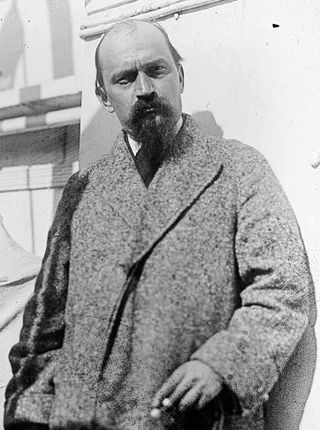
Ivan Meštrović was a Croatian sculptor, architect, and writer. He was the most prominent modern Croatian sculptor and a leading artistic personality in contemporary Zagreb. He studied at Pavle Bilinić's Stone Workshop in Split and at the Academy of Fine Arts Vienna, where he was formed under the influence of the Secession. He traveled throughout Europe and studied the works of ancient and Renaissance masters, especially Michelangelo, and French sculptors Auguste Rodin, Antoine Bourdelle and Aristide Maillol. He was the initiator of the national-romantic group Medulić. During the First World War, he lived in emigration. After the war, he returned to Croatia and began a long and fruitful period of sculpture and pedagogical work. In 1942 he emigrated to Italy, in 1943 to Switzerland and in 1947 to the United States. He was a professor of sculpture at the Syracuse University and from 1955 at the University of Notre Dame in South Bend, Indiana.
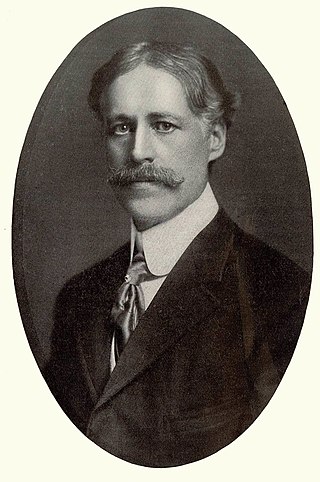
William Ordway Partridge was an American sculptor, teacher and author. Among his best-known works are the Shakespeare Monument in Chicago, the equestrian statue of General Grant in Brooklyn, the Pietà at St. Patrick's Cathedral in Manhattan, and the Pocahontas statue in Jamestown, Virginia.

The sculpture of ancient Greece is the main surviving type of fine ancient Greek art as, with the exception of painted ancient Greek pottery, almost no ancient Greek painting survives. Modern scholarship identifies three major stages in monumental sculpture in bronze and stone: the Archaic, Classical (480–323) and Hellenistic. At all periods there were great numbers of Greek terracotta figurines and small sculptures in metal and other materials.
Events from the year 1961 in art.

Joseph Erhardy was an American sculptor.
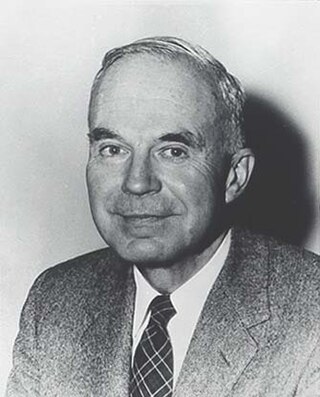
Walker Kirtland Hancock was an American sculptor and teacher. He created notable monumental sculptures, including the Pennsylvania Railroad World War II Memorial (1950–52) at 30th Street Station in Philadelphia, and the World War I Soldiers' Memorial (1936–38) in St. Louis, Missouri. He made major additions to the National Cathedral in Washington, D.C., including Christ in Majesty (1972), the bas relief over the High Altar. Works by him are presently housed at the U.S. Military Academy at West Point, the Library of Congress, the U.S. Supreme Court, and the United States Capitol.
Constantin Lucaci was a Romanian contemporary sculptor, best known for his monumentalist sculptures and his kinetic fountains most made from stainless steel, among which those from the Romanian cities of Reșița and Constanța are best known. He was born in Bocșa Română, today a part of Bocșa, Caraș-Severin County.
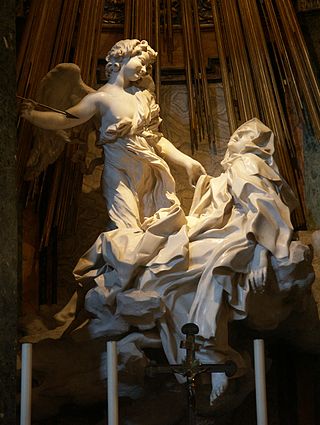
Baroque sculpture is the sculpture associated with the Baroque style of the period between the early 17th and mid 18th centuries. In Baroque sculpture, groups of figures assumed new importance, and there was a dynamic movement and energy of human forms—they spiralled around an empty central vortex, or reached outwards into the surrounding space. Baroque sculpture often had multiple ideal viewing angles, and reflected a general continuation of the Renaissance move away from the relief to sculpture created in the round, and designed to be placed in the middle of a large space—elaborate fountains such as Gian Lorenzo Bernini‘s Fontana dei Quattro Fiumi, or those in the Gardens of Versailles were a Baroque speciality. The Baroque style was perfectly suited to sculpture, with Bernini the dominating figure of the age in works such as The Ecstasy of St Theresa (1647–1652). Much Baroque sculpture added extra-sculptural elements, for example, concealed lighting, or water fountains, or fused sculpture and architecture to create a transformative experience for the viewer. Artists saw themselves as in the classical tradition, but admired Hellenistic and later Roman sculpture, rather than that of the more "Classical" periods as they are seen today.

Chauncey Bradley Ives was an American sculptor who worked primarily in the Neo-classic style. His best known works are the marble statues of Jonathan Trumbull and Roger Sherman enshrined in the National Statuary Hall Collection.

Ismail Fatah Al-Turk was an Iraqi painter and sculptor born in Basra, Iraq, noted for his abstract art, monumental sculpture, and public works and as part of the Baghdad Modern Art Group, which fostered a sense of national identity. His monument, al-Shaheed Monument is the most iconic public monument in Baghdad.

Wahbi al-Hariri-Rifai was a Syrian American artist who has often been called "the last of the classicists". As an artist he was remarkably prolific in the last years of his life despite a protracted and painful struggle with terminal cancer. He was also an accomplished architect, archaeologist, and author. His artwork has garnered international recognition and praise both in his lifetime and posthumously.

José Mariano de Creeft was a Spanish-born American artist, sculptor, and teacher known for modern sculpture in stone, metal, and wood, particularly figural works of women. His 16-foot (4.9 m) bronze Alice in Wonderland sculpture climbing sculpture in Central Park is well known to both adults and children in New York City. He was an early adopter, and prominent exponent of the direct carving approach to sculpture. He also developed the technique of lead chasing, and was among the first to create modern sculpture from found objects. He taught at Black Mountain College, the Art Students League of New York, and the New School for Social Research. His works are in the Whitney Museum, the Metropolitan Museum of Art, the Museum of Modern Art, the Smithsonian American Art Museum, and many other public and private collections.
Jaber Alwan is an Italian artist and painter of Iraqi descent.

Roland Khoury (1930—1988) was a Syrian painter.
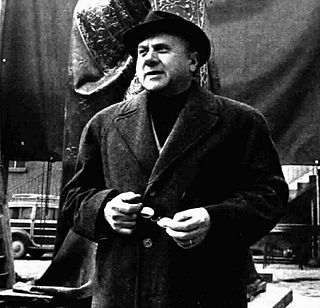
Francesco Messina was an Italian sculptor of the 20th century.
Eugen Ciucă was a Romanian-American artist known for his monumental sculptures, vivid paintings and drawings of delicate feminine figures. He spent the most successful years of his career in Italy, where he created many works inspired by the Divine Comedy and its author Dante Alighieri. Ciucă's art has been displayed in nearly 100 exhibitions across Europe and the United States.

Patricia Cronin is a New York-based feminist cross-disciplinary artist. Since the early-1990s, Cronin has garnered international attention for her photographs, paintings and sculptures that address contemporary human rights issues. Cronin's conceptual artistic practice transits across many aesthetic platforms addressing social justice issues of gender, sexuality and class, including: lesbian visibility, feminist art history, marriage equality and international rights of women. She subverts traditional art images and forms in a wide range of two and three-dimensional time-honored artists' materials and breathes new life into these images and forms by injecting her specific political content. Her critically acclaimed statue, "Memorial To A Marriage", is the first and only Marriage Equality monument in the world. A 3-ton Carrara marble mortuary sculpture of her life partner and herself was made before gay marriage was legal in the U.S., and has been exhibited widely across the country and abroad. Cronin began her career working for the Anne Frank Stichting (Foundation)Archived 2015-10-25 at the Wayback Machine in Amsterdam installing the traveling exhibition "Anne Frank in the World" in Europe and the U.S. Giving presence to female absence is a consistent thread that runs through and connects each body of work.
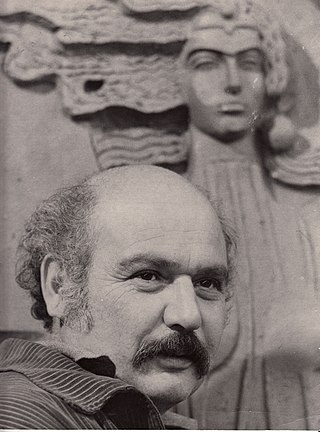
Ara Harutyunyan was an Armenian monumental sculptor, graphic artist, People's Artist of Armenia, corresponding member of Academy of Fine Arts of USSR and Russian Academy of Arts, professor.

The Syrian Cultural Caravan is an artistic and cultural movement led by Syrian artists. Started in 2014 as a project called "Freedom for the Syrian People", it took the form of a road trip, taking off from France and continuing across Europe. In face of the success met in 2014, the project became a movement entitled the "Syrian Cultural Caravan". The project aims at bringing a wide diversity of artists together around a multi-format exhibition mixing paintings, photographs, dance, music, film screenings, as well as debates and the sharing of food. The goal of the project is "to promote Syrian civil society and contemporary Syrian art and culture" by debunking the public's expectations. Artists create a platform for debate on which they can offer their own narrative to counterweight the mainstream narrative of the media.
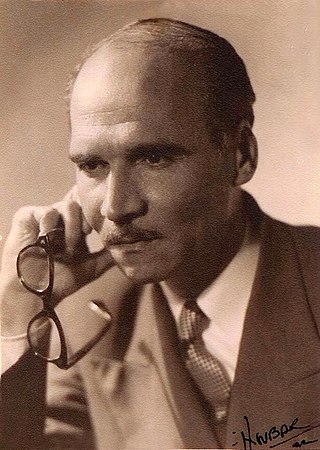
Mahmoud Jalal, , was a Libyan-born Syrian artist, painter, sculptor, medalist, and one of the early leaders of the modern art movement in Syria.